From The CRPG Addict
 |
| Spider webs posed a (mild) obstacle on some of this session’s dungeons. |
A second session with Abandoned Places has shown it to be an adequate but unmemorable Dungeon Master clone. Most of the things I initially liked about it–elements in which it departed from the usual Dungeon Master template–have not really compensated for a certain lack of imagination and challenge.
You’ll recall that the plot involved the resurrection of four long-dead heroes to save the land of Kalynthia from a new threat posed by a threatening figure named Bronakh. It turns out that I was missing a large part of the backstory, kept in a book separate from the game manual called The 23rd Chronicles of Kalynthia. The 40 pages of this book tell a Tolkienesque history, full of allusions, partial biographies, and heroes lost to history except for their names. It’s an impressive effort, one that suggests epic ambitions for the series that were frustrated by poor sales or lack of interest.
It’s probably not worth trying to summarize all of it, but I’ll cover it in broad strokes. Thousands of years ago, Kalynthia was an icy world with a technologically advanced population. The manual is written from the perspective of someone who doesn’t understand the ancient technology (“armored carriages that could release explosions of fire”), but the population clearly had firearms, bombs, airplanes, and tanks. Some leader named Zander united this world through a combination of diplomacy and conquest. A million-year peace followed in which the population built shining cities and fortresses, tunneled deep into the earth and built entire cities underground, and mastered the art of magic.
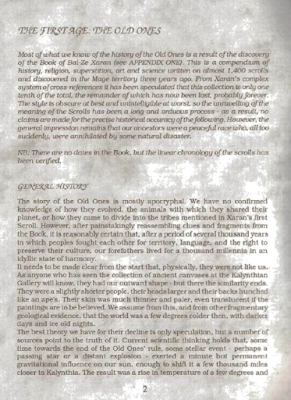 |
| A long backstory is delivered in a 40-page book with thick text and no illustrations. |
A warming of the world caused this ancient population to decline and vanished, replaced in dominance by the human creations of two gods, Kiri-Sam and Gardi. After several thousand years of tribal living, a figure named Drexel the Great established the first major civilization. Guilds of craftsmen and storytellers thrived in this civilization, and the most powerful of the guildmasters became the world’s first kings and queens.
Several generations later, a queen named Solara ruled a Camelot-like kingdom when a mysterious, dark, charismatic stranger named Zorin became her steward. Her husband died under mysterious circumstances, and she remarried Zorin, bearing from him a child named Bronakh. A “strange and willful” child, Bronakh exerted a power over his mother that caused her to disown her previous children and make one desperate attempt after another to please him. As she descended into insanity, Bronakh was raised by his wetnurse, a gypsy witch named Xonia. As he grew, he became lovers with Xonia’s daughter, Ellida. Anyone who spoke against him or Xonia suffered a mysterious death.
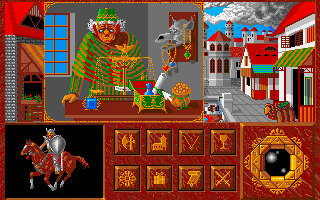 |
| Here’s a random shot of the guy who runs the jewelry shop in town. |
When Solara died, Bronakh declared himself king and Ellida used enchantments to help him win the support of the people. Solara’s older sons (Nikor, Igon, Drel, and Erik) raised an army to oppose Bronakh, but Ellida filled their heads with mistrust for each other, so that when the battle came, the brothers’ armies turned on each other and left Bronakh unharmed and victorious. However, Bronakh was mentally exhausted by the many glamours that he’d cast to get this far, and he ended up retreating to an island in the northwest and establishing his kingdom there. On the mainland, with the help of a great Council, the four brothers established four separate kingdoms.
Generations passed and peace reigned for a while, but eventually Bronakh stirred and began sending abominations to the mainland to threaten the populace. The citizenry had to retreat into walled cities to avoid certain death. The rulers of the four kingdoms decided to commission warriors and mages to clear the world of these monsters. Lacking the resources to establish a true army, they selected the 12 most talented specialists in war, magic, and healing, commissioning a Great Contest to suss them out. Bronakh tried to sabotage the contest by sending his own son, Ignis, to compete, but King Soron discovered the plot and destroyed Ignis by pouring a jug of holy water on his head. The 12 heroes did their jobs, and ultimately Bronakh was bound and tossed into a volcano. But the rulers knew that he was immortal and would eventually return, and thus they used magic to turn the 12 heroes to stone and stuck them in the Temple of Heaven’s Light to await the world’s need.
So this is all nice to know, but what strikes me more is how little it would have affected my experience of the game if I’d never found this document. Because as with
Dungeon Master, the story is simply a framing story. Telling a more elaborate framing story is like putting a more ornate frame around a painting–it may be an interesting object in and of itself, but it doesn’t fundamentally change the experience of the central piece. What’s annoying is that
Abandoned Places at first shows every intent of abandoning the framing story as the main plot device. It has an overworld with numerous interesting-looking locations. Wouldn’t it be nice if visiting those locations produced NPCs and encounters that referred back to the story? Perhaps a couple of places where knowledge of the story helps you solve a puzzle? Alas, the story hardly references actual locations on the map (it mostly contradicts it), and the places you can visit either have generic menu towns or nothing at all. You can’t even visit the different dungeons out of order. Thus, the overworld just becomes an interlude between dungeon levels in a game that otherwise plays like most other games in its sub-genre.
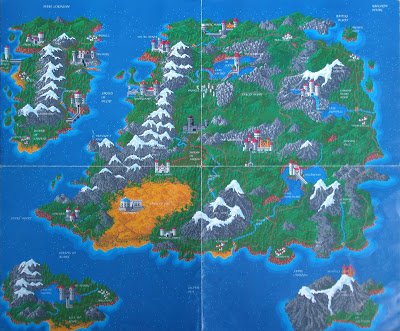 |
| I forgot to include the overworld map int he last entry. Here it is. |
We began last session with four of the heroes awakened. It is unclear why there were only four, who awakened them, and what happened to him. The four heroes had to fight their way out of the Tempe, make their way to the mainland, and visit over a dozen locations before finding anything to do at Souls Abbey. There, it wasn’t even clear that the (unidentified) person who greeted them knew who they were or why they were there; he simply sent them on a “prove yourself” quest to clear out monsters from a dungeon.
The dungeon was a single 22 x 22 level with the same sort of navigation puzzles already described: buttons and levers on the walls, keys and keyed doors, squares of fire or water that you must avoid or take damage crossing, pressure plates, and illusory walls. There were enemies in the form of flying skulls and zombie-like humanoids.
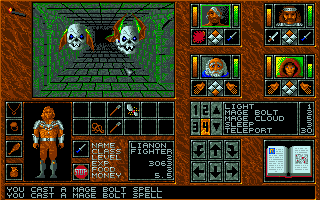 |
| How did skulls acquire wings? How do they affix? |
When I cleared the monsters and returned to the abbey, the unidentified representative–again not suggesting that he knew anything about us–suggested we go seek the Book of the World in the “old library” at Kal Kalon. Kal Kalon is the capital of the land, with a full set of services, so I certainly didn’t mind the visit. I sold some excess equipment and leveled up before clicking on the “sage” icon option. There, another unidentified old man gave me permission to enter the library.
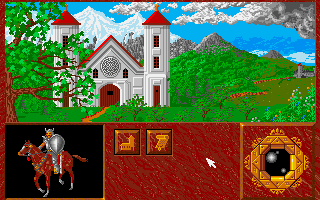 |
| Souls Abbey. |
The library was three levels, but fragmented so that they really only took up two 22 x 22 level spaces. Other than the textures suggesting books at certain points, the only thing the dungeon introduced was furniture that I had to push out of the way and cobwebs that I had to destroy. (The only way I could find to do it was with the priest’s “Fire Path” spell, but I feel like there must be other options.) Enemies included what looked like ghosts of priests and hairy monsters with long claws and razor teeth. In the end, I got the Book of Worlds and returned to the abbey.
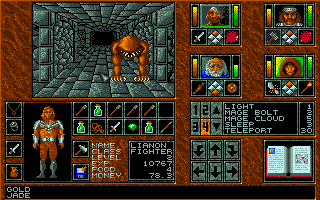 |
| I don’t even have a placeholder name for these guys. |
It turns out that when you activate the Book of Worlds, it activates a little auto-map in the lower right corner. But it shows only a small space and doesn’t annotate puzzles or anything. I haven’t been mapping very faithfully for reasons I’ll discuss below, but if this were the sort of game where you really
had to map, I don’t think the automap would do much to help you.
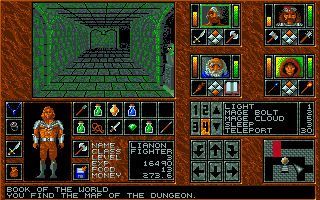 |
| Note the automap in the lower right window. |
Back at the abbey, the priest finally figured out that we were four of the 12 heroes from hundreds of years ago. He then said we’d find a valuable scroll at the Steps and sent us away again.
The Steps are a mountain range southeast of the abbey. From the manual, I learned that when searching for a dungeon entrance over a large area, you need to turn the “search” option on in the overworld interface. From a commenter, I learned that you needed to be dismounted for this to work. Eventually, we found the dungeon entrance.
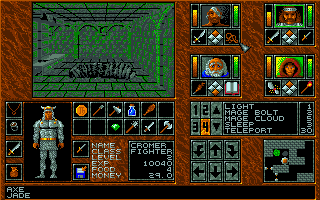 |
| The Steps featured the first pit, and thus the first use of a rope. |
It was another pair of 22 x 22s. This dungeon introduced a pit that we had to climb down, explore for a while, and climb back up. Ropes we’d found plus my fighters’ “climbing” skills did the trick.
Finally, in this dungeon, we found our first item of armor–a suit of ringmail. I had begun to wonder if the game even had armor given that there’s no explicit slot for it. It turns out that the character figure in the inventory section has been reflecting armor all along. When I dropped the ringmail on a fighter, he gave up his previous suit of leather.
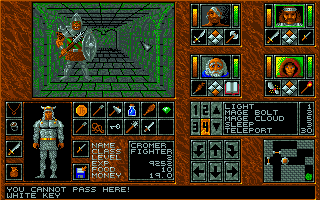 |
| My fighter wears a fancy new set of ringmail as we fight some kind of warrior. |
Enemies in the Steps were mostly skeletons and large, armored warriors. The culmination was a scroll that I couldn’t read. I took it back to the abbey, and the priest couldn’t read it either. He told me to take it to the “wise” at Kal Kalon. He, in turn, said that the scroll discussed the Ruling Symbols.
The Ruling Symbols are some kind of magical items. They were created by a group of powerful spell casters to keep evil from Kalynthia. The work was completed too late. Evil got to them. Then after an adventurous fight of mighty heroes the items were brought back to the Council of Elders. They decided that these items may help forthcoming generations. So they cut the items into pieces, and hid the around the empire. Only the worthy ones can find them. You will need all of these artifacts to destroy Bronakh.
The Ruling Symbols turn out to be three items: the Sword of Darkness, the Staff of Supremacy, and the Globe of Forthcoming. Each is in three pieces, leaving nine total pieces to find. For each piece, the first one will somehow lead me to the others. The scroll describes the location of each first piece: the Broken Isles, the Sands of Fire, and Seers Point. So it appears I have a bit of freedom at this point. I can start in any of those three locations and then either finish finding an entire item before moving on to the next, or find all “first pieces” before the seconds, and so on.
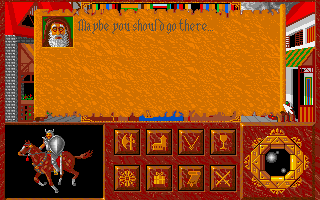 |
| The wise man doesn’t seem to care one way or another if I save the world. |
We’ve seen that Abandoned Places doesn’t break much new ground, although it initially seems to, in its narrative or game world. That leaves how it plays as a dungeon crawler, and as I said before, it distinguishes itself in neither mechanics nor challenge. To start, I haven’t suffered a single character death the entire game so far. In fact, I don’t think any of my characters have seen their hit points drop below 50%. Enemies hardly ever hit, and when they do, they don’t hit that hard.
Combat itself is unsatisfying. The cool-down period for attacks is just a little too long, so a lot of the time you and the enemy are just standing there looking at each other. Even if combat was faster and harder, the game lacks many of Dungeon Master‘s tactics. Closing them in doors doesn’t work. Combat waltzing (check the glossary!) doesn’t work because enemies are always facing you. Enemies have fixed patrol zones, so you can’t do the backpedal.
 |
| Fighting a ghostly librarian in the library. Trying to close the door to crush him just closed it behind him. |
Meanwhile, the puzzles have also lacked any real challenge. They’ve all been of the find-the-switch-here-to-open-the-wall-there variety. I’ve been stuck a couple of times, but mostly because I failed to note a wall switch, or because I hadn’t yet tested every wall to see if it was illusory. As the game has progressed, the puzzles haven’t gotten harder so much as more distant, so a switch might open a wall on the other end of the dungeon, or even another dungeon level. Usually in games like this, I map everything I can without touching anything, then start experimenting witch switches and plates. I do it carefully because you never know when a switch might be temporary, or a plate might open one door but close another. But here, the causes and effects are so rudimentary that I’ve started activating every switch the moment I find it.
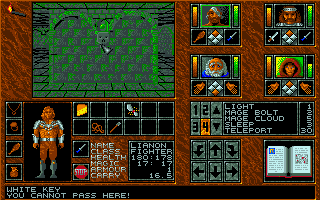 |
| The brick above the cursor is a button. |
Abandoned Places retains two quirks of Dungeon Master that have always annoyed me: inability to see the names of your enemies and inability to see weapon statistics. At least in Dungeon Master, you could track the damage done to enemies and basically figure out which item was better, but in Abandoned Places, the only feedback you get is whether you hit or missed. Naturally, the ease of combat makes it a lesser consideration for now. My characters have upgraded from clubs and daggers to short swords, maces, and axes. I’ve found two magic weapons: a magic club and a magic dagger. I gave the club to my cleric, who almost never gets to act in combat and thus has the lowest experience point total of the group (he gets most of his experience from “Minor Cure Wounds” and “Create Food” spells). To help him get more, I have him attack to the rear. After my fighters attack forward in combat, I spin around and give the cleric an attack or two. My mage remains aiming forward, as she can cast offensive spells past the fighters.
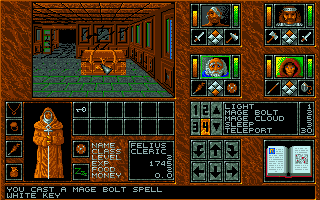 |
| Opening a chest with a key. You can see the mage’s spell list here. |
Miscellaneous notes:
- So far, no dungeons have allowed enemies to respawn. If I did end up feeling I needed a little grinding, I’d have to do it with random encounters in the overworld.
- The game’s font makes a w look like an m. It’s driving me crazy.
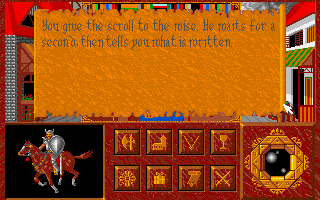 |
| The mise maits the scroll before telling me what is mritten. |
- I’ve found some missile weapons, including a bunch of shurikens, but picking them up after battle is annoying even in games where you desperately need them. There’s no chance I’m doing that here.
- I found a reasonable amount of gold in the last dungeon, plus lots of items to sell for more gold. I’m just hesitant to spend any of it.
 |
| This dungeon room had piles of gold on the floor. |
- Food depletes very fast, and “Create Food” doesn’t create much. I probably have to spend 5 minutes casting “Create Food” multiple times, passing it around, and eating it to get 15 interrupted minutes of dungeon crawling. Once characters are starving, they periodically lose 1 hit point, accompanied by an “oof!” I’m not sure, but I think the standard hit point regeneration might be faster than the 1 point they’re losing by starving, but the “oof!” is so annoying that I feed them. The whole system exists only to annoy you.
- Half the time you try to visit some place in town, you get a screen saying that it’s “closed now.” Most of the time, if you acknowledge the message and try again a couple times, you can get in. Yet another thing that seems to exist solely to annoy.
- Spellcasters get spells automatically on leveling up. So far, I’ve been relying heavily on the mage’s “Mage Bolt” and “Mage Cloud.” My priest has a spell called “Death Clow”; I don’t know if it was supposed to be “claw” or “glow,” but either way it doesn’t seem to do anything. There are some other mysterious ones, such as the priest’s “Create Water” (characters don’t need water separately from food) and the mage’s “Teleport,” which seems to be the “recall” part of a “mark/recall” spell except I can’t figure out how to specify the “mark” part.
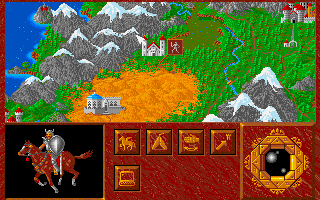 |
| Moving from the abbey to Kal Kalon. |
Late in this session, I was Googling around to see if I’d missed any documentation on spells. I took note of a walkthrough, checking out only what it said for the parts that I’d already played, and I realized that an entire facet of the game had escaped my notice. The Soul Abbey is one of only three possible places that you can wind up where they give you the initial series of quests. The other two are the castle called Twilight and Vo Marris on the Isle of Mists. Each one of them sends you to a different starter dungeon. The library at Kal Kalon is the same for all three, but then each sends you to a different place to look for the scroll. The three potential paths converge at the point where I am now. It’s an interesting approach that enhances replayability.
I’m considering whether to declare that I’ve explored this one enough and just move on, not because it’s bad, but because it seems likely to take another 20 hours without offering anything substantially different. I’ll give it at least one more session and perhaps a quick scout of other sites to see if someone else has documented the endgame.
Time so far: 9 hours
Original URL: http://crpgaddict.blogspot.com/2020/05/abandoned-places-empty-frame.html

















